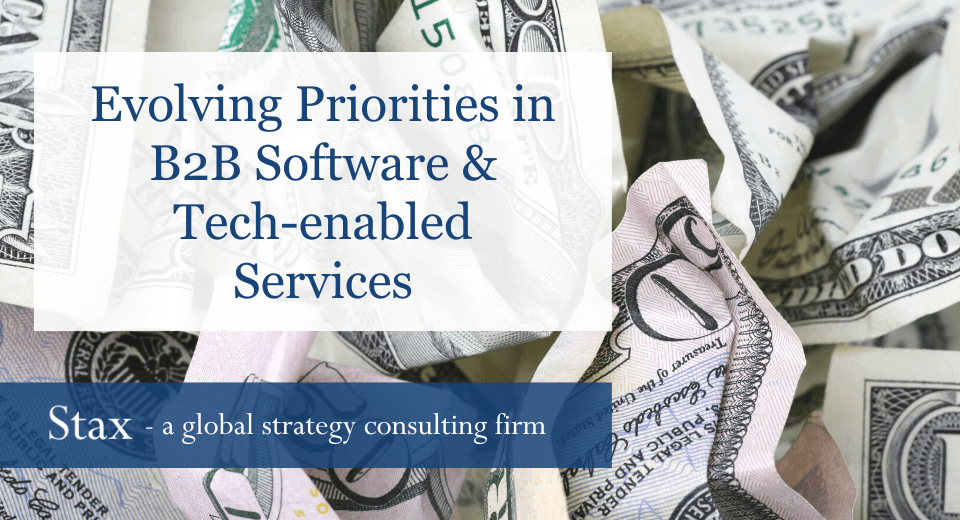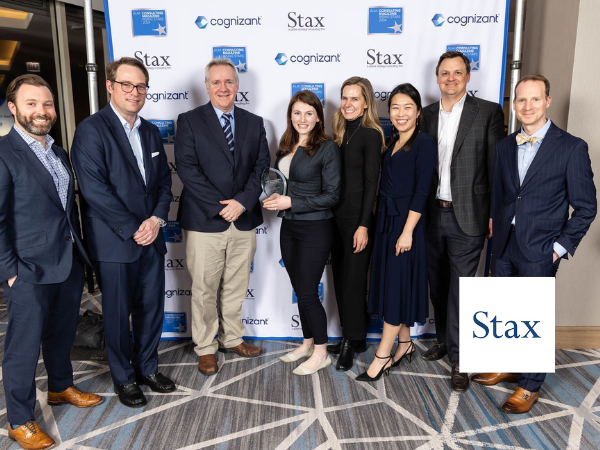Evolving Priorities for B2B Software and Tech-Enabled Services in a Changing Economic Landscape
Evolving Priorities for B2B Software and Tech-Enabled Services in a Changing Economic Landscape

Impact of Covid on IT Services and Software Spending
The immediate aftermath of the global pandemic saw varying degrees of impact on spending for B2B software and tech-enabled services given market uncertainty. As private equity investors sought to adjust how they approached potential opportunities and manage the investment landscape, a lot of Stax's engagements during that time focused on helping our equity sponsor clients better understand the immediate and short-term impact of Covid-19 on specific tech assets.
Common areas of focus included:
- Understanding the market exposure of certain technologies and services
- Evaluating which customer segments (e.g., across dimensions of size, vertical, tech-maturation etc.) were being hit hardest and longest
- Assessing the impact of delay in spend or potential trade downs among customers
- Determining which competing B2B software and tech-enabled vendors were likely to be more challenged or best positioned to serve customer’s evolving needs
After initial delays in spending, the pandemic saw an acceleration of spending and Covid-driven adoption across a variety of B2B software and tech-enabled services applications—especially as organizations sought to increase efficiencies and minimize costs.
Additionally, the accelerated uptake of digital channels during the pandemic led to a further increase in overall technology investments among businesses—ecommerce, BDR, cloud storage, cybersecurity-related tech investments, as well as hardware (computers, phones, etc.).
Further, Work-From-Home (WFH) initiatives, higher rates/complexity/cost of data security breaches, growth of cloud storage, and centralized tech platforms all helped drive demand for a variety of tech-enabled workflow and business processes solutions.
However, the spending spree and accelerated adoption of many B2B software and tech-enabled services over the past 18-24 months has and is expected to level set across many applications. Businesses are re-evaluating their IT service and software priorities as they are faced with mounting uncertainty and risk factors such as inflation, supply chain disruptions, recessionary concerns, and geopolitical tensions. Additionally, many businesses are re-evaluating their IT service and software priorities and adjusting to recent “Covid-bumps” that resulted from initial Covid-driven delays in investment.
Looking ahead, businesses’ IT priorities are shifting
While businesses are generally reluctant to spend during periods of recession, spending expectations regarding B2B software and tech-enabled solutions are still largely positive, especially given the benefits in optimizing operations, improving efficiencies, productivity, and profitability that technology investment has proven over the past couple of years.
The post-pandemic landscape and the evolving economic environment are impacting the way B2B software and tech-enabled services spending decisions are being discerned. Specifically, spending is expected to be increasingly selective, given labor shortages and the growing complexity of technology infrastructure and environments, which was further accelerated during Covid—among SMBs in particular.
As such, we have seen priorities shift in not only where businesses are considering investing in technology but also in how they are considering technology service providers.
By way of example, whereas a point, best-in-breed offering may have been more attractive pre-pandemic, the rapid adoption of workflow automation solutions and cloud-based applications has created a greater need for firms to consolidate and professionalize their current infrastructure.
The increased complexity of tech environments and the concerns regarding the ability to effectively manage performance in these new and evolving environments has impacted the way businesses consider the benefits and the value provided by software vendors and the tradeoffs between best-in-breed point solutions vs. legacy providers.
A functional “good enough” solution able to help consolidate a business’s tech stack with minimal impact on the existing infrastructure may be preferred over a best-in-breed alternative. Further, businesses may accept a price premium to buy from existing platforms over new point solutions given the greater sensitivity towards drawn-out integrations that would supplant vs. supplement existing solutions and processes.
IT software vendors’ ability to differentiate and win across the dimensions of price, quality, or breadth of offering is no longer sufficient. Demonstrating a clear right-to-win requires a more tailored and targeted approach that will incorporate firm’s organizational priorities, the shifting nature of decision-making, and awareness of firm’s existing tech stack.
How Stax is helping our equity sponsor clients approach their investments in Tech and Software Services
As we approach a post-Covid investment landscape, the frothiness in the market has and is expected to subside, especially given the economic environment. While the deal market remains highly competitive, the way in which equity sponsors are considering investments in technology and software services has shifted across some verticals.
Stax has identified key areas to help guide our private equity client’s considerations in a transitionary environment:
Covid-bump or Long-term Growth: Define the longevity of any Covid-bump impact on B2B software and tech-enabled services spending across applications in light of concerns regarding the current inflationary environment, the potential impact from interest rates, and concerns regarding a recession.
Are there strong industry agnostic tailwinds at play that are expected to see sustained growth moving forward and remain key drivers of spending and adoption? Are headwinds (e.g., closing retail stores) likely to offset positive demand trends (e.g., continued adoption of retail POS and inventory management software)? Accounts payable software solutions are an example of solutions that are expected to see sustained growth moving forward given the lack of clear headwinds, clear value proposition (efficiency and ease of use, ease of onboarding vendors etc.), and entrenched customers.
Need to Have vs. Nice to Have: Ensure that recent and potential B2B software and tech-enabled services investments are tied to mission-critical applications and that the implementation of B2B software and tech-enabled services has a long-term benefit that will spur ongoing investment.
While enablement and payment solutions have seen a significant uptick in growth across a variety of sectors and verticals, there are some verticals where usage is expected to decline in a post-Covid world (e.g., many SMBs in the wellness services space utilized digital applications as a short-term means to help address an immediate challenge vs. a long-term investment as they reverted to traditional in-person payment processes as gyms, yoga studios, etc. reopened. '
In the enterprise space, usage of remote solutions accelerated during the pandemic given IT teams’ need to solve helpdesk issues remotely, but growth in licenses may be flat going forward as the short-term need was addressed without continued investment required).
Meeting Customers at their Level: Coming out of the pandemic, many decision-makers are more educated—especially among SMBs—and have a better understanding of the ROI and benefits of IT services and software applications that were previously new.
Resulting from the spikes in remote work, increased burden from digitization on the IT infrastructure, and mounting concerns regarding cybersecurity risks, IT teams are increasingly aware of the value of identity management, network connectivity, and end-point security tools and are expected to continue to invest in these services while also being more selective and demanding in what they want from these solutions as their awareness and comfort level grows. Additionally, this has also created tailwinds for MSPs and service providers—complexity of the ask has made businesses more amenable to outsourcing critical functions.
Understanding Who the Decision-Makers are to Target: Assess the impact Covid has had on how decisions regarding IT services and software are being made, by whom, and how this impacts spending, budgeting, and vendor consideration processes.
The decision-making for certain applications and solutions that have experienced strong adoption growth during the pandemic (e.g., GRC and workflow automation applications) has become more centralized given the growing operational value of these solutions (less siloed), increased awareness of the solution’s benefits, and strategic criticality of their usage. As such, solutions need to cater to an evolving set of organizational needs and stakeholders.
Understanding Evolving Pain-Points and Preferences: As customer awareness, education, decision-making, and organizational needs have evolved, this presents opportunities for B2B software and tech-enabled service providers to align with shifting customer preferences.
The accelerated adoption of B2B software and tech-enabled services across certain verticals and enterprise-size segments have made previously less addressable segments of the market (given their limited usage and value of these services prior to the pandemic) potentially viable customers to target. Specifically, in professional services resource management, we have seen a greater appreciation of specialized point solutions’ configurability and workflow automation capabilities among a greater segment of the SMB segment that were likely less addressable pre-Covid given their accelerated investments in their IT infrastructure and tech stack.
Evaluating Competitive Shifts during Covid: Determine how the competitive landscape has changed during Covid, who is ahead, who is lagging, and how this may change moving forward.
B2B software and tech-enabled service providers have had different fortunes. Those service providers (e.g., payments integrated B2B software) that have been a bit more cloud forward were able to adapt their sales/deployment strategy to a remote environment faster. Stax has seen some verticals continue to show a preference for best-of-breed (easier given integrations are improving), leading to strong growth. Other verticals have seen vendors with integrated solutions/suites growing rapidly. The changing market landscape has made it more challenging to make the right bets on winners and losers without a field-level understanding of evolving customer needs and competitive dynamics.
About the author: Owen Tindle is a Director at Stax in our Boston office with over 15 years of experience providing strategic advice to both private equity and corporate investors, as well as management teams and corporate business units.
Read More
All Rights Reserved | Stax LLC | Powered by Flypaper | Privacy Policy






